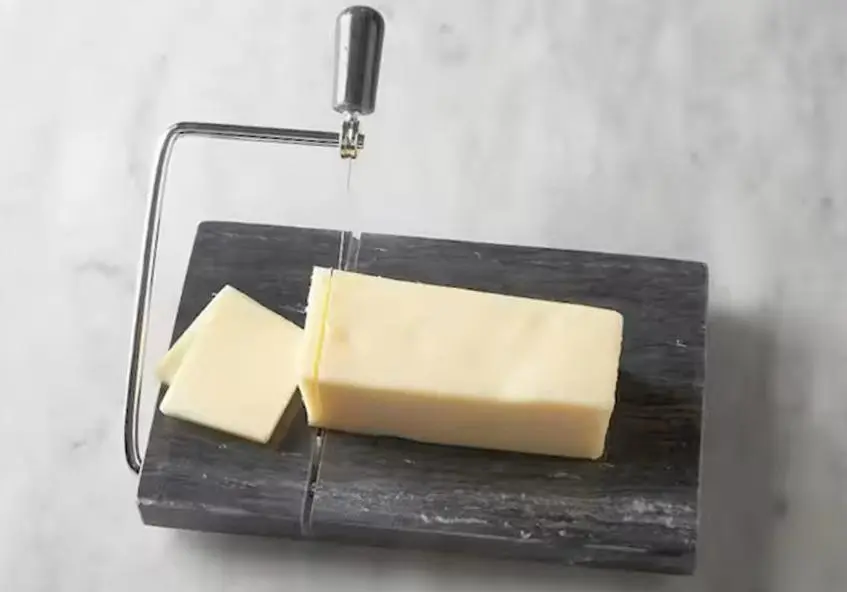How to Use a Black Marble Cheese Slicer Properly?
2025-07-15 19:04:25

Mastering the art of using a Black Marble Cheese Slicer can elevate your culinary experience and presentation skills. This elegant kitchenware combines functionality with sophistication, making it a must-have for cheese enthusiasts. To use your marble cheese slicer effectively, start by ensuring the marble base is clean and at room temperature. Place your cheese block on the smooth surface, positioning it against the wire. Gently press down on the handle, allowing the wire to glide through the cheese. The marble's natural coolness helps maintain the cheese's texture and flavor during slicing. Adjust the wire's angle for your desired thickness, whether you prefer paper-thin slices for delicate appetizers or thicker cuts for hearty sandwiches. Remember, the key to perfect slices lies in smooth, consistent motions and letting the slicer's weight do most of the work. With practice, you'll find that your Black Marble Cheese Slicer becomes an indispensable tool for creating impressive cheese boards and enhancing your culinary presentations.
Does Marble Affect Cheese Temperature? Best Practices for Perfect Slices
The unique properties of marble play a significant role in cheese preservation and slicing quality. Marble's natural thermal conductivity helps maintain an ideal temperature for cheese, keeping it cool without freezing. This characteristic is particularly beneficial when serving cheese platters, as it prevents the cheese from becoming too soft or oily too quickly.
Temperature Control and Cheese Texture
Marble's cooling effect contributes to achieving clean, precise cuts. When cheese is slightly chilled, it's less likely to stick to the wire or crumble during slicing. This results in more attractive, uniform slices that maintain their shape and texture.
Optimizing Slicing Techniques
To maximize the benefits of your black marble cheese slicer:
- Allow hard cheeses to sit at room temperature for 15-20 minutes before slicing to prevent cracking.
- For softer cheeses, use the marble's cooling properties to firm them up slightly before slicing.
- Experiment with different wire tensions to accommodate various cheese textures.
- Clean the marble surface between different cheese types to prevent flavor mixing.
By leveraging the natural properties of marble, you can enhance both the presentation and taste of your cheese selections, making every slice a culinary delight.
How to Clean & Maintain Your Marble Cheese Slicer? Dos and Don'ts
Proper care of your marble cheese slicer ensures its longevity and maintains its elegant appearance. Follow these guidelines to keep your kitchenware in pristine condition:
Cleaning Dos:
- Wipe the marble surface with a soft, damp cloth after each use.
- For deeper cleaning, use a mild soap solution and rinse thoroughly.
- Dry the slicer immediately with a soft towel to prevent water spots.
- Periodically clean the wire with a soft brush to remove cheese residue.
Maintenance Don'ts:
- Avoid using abrasive cleaners or scouring pads that can scratch the marble.
- Never submerge the entire slicer in water, as this can damage the wire mechanism.
- Don't use acidic cleaners, as they can etch the marble surface.
- Refrain from placing hot items on the marble, which can cause thermal shock.
Long-term Care Tips:
To preserve your marble cheese slicer's beauty and functionality:
- Apply a food-safe marble sealer annually to protect against stains.
- Store the slicer in a dry place to prevent moisture damage.
- Inspect the wire regularly and replace it if it becomes frayed or loose.
- Use felt pads under the slicer's feet to protect countertops and prevent slipping.
By adhering to these care instructions, your black marble cheese slicer will remain a cherished kitchenware piece for years to come, consistently delivering perfect cheese slices for your culinary creations.
Marble vs Stainless Steel Cheese Slicers: Which Performs Better?
When it comes to cheese slicers, both marble and stainless steel options have their merits. Understanding the unique qualities of each can help you choose the best tool for your culinary needs.
Marble Cheese Slicers: Elegance Meets Functionality
Advantages of marble slicers:
- Natural cooling properties that help maintain cheese texture
- Aesthetic appeal that doubles as a serving board
- Durability and resistance to odors and bacteria
- Ability to handle a wide variety of cheese types
Considerations for marble slicers:
- Heavier and less portable than stainless steel options
- Require more careful maintenance to prevent staining or etching
- Initial cost may be higher than some stainless steel models
Stainless Steel Cheese Slicers: Practicality and Precision
Advantages of stainless steel slicers:
- Lightweight and easy to maneuver
- Often dishwasher-safe for easy cleaning
- Typically more affordable than marble options
- Resistant to rust and corrosion
Considerations for stainless steel slicers:
- May not offer the same temperature control as marble
- Less visually appealing for serving purposes
- Some models may struggle with very hard cheeses
Performance Comparison
When it comes to performance, both types of slicers can deliver excellent results. Marble slicers excel in temperature regulation and presentation, making them ideal for cheese enthusiasts who frequently entertain. They perform exceptionally well with a variety of cheese textures, from soft brie to hard parmesan.
Stainless steel slicers, on the other hand, offer precision and ease of use, particularly for everyday cheese slicing tasks. They're often preferred in professional kitchens for their durability and efficiency.
Ultimately, the choice between marble and stainless steel depends on your specific needs, preferences, and the types of cheese you typically enjoy. For those who prioritize both functionality and aesthetics, a high-quality Black Marble Cheese Slicer offers the best of both worlds, combining elegant design with superior slicing performance.
Conclusion
Mastering the use of a Black Marble Cheese Slicer can significantly enhance your culinary experience, from everyday meals to sophisticated entertaining. By understanding the unique properties of marble, maintaining your slicer properly, and appreciating its advantages over other materials, you can make the most of this elegant kitchenware. Whether you're a cheese connoisseur or simply someone who appreciates quality kitchen tools, a marble cheese slicer is a worthwhile investment that combines functionality with timeless style.
Ready to elevate your cheese slicing experience? Explore BSTNMP's range of premium Black Marble Cheese Slicers. With over 15 years of expertise in crafting high-quality kitchenware, BSTNMP offers slicers that blend elegance with precision. Our marble slicers feature adjustable thickness settings, non-slip bases, and are designed to keep your cheese at the perfect temperature. Experience the difference that expert craftsmanship makes in your kitchen. Contact us at [email protected] to learn more about our products or to place an order. Upgrade your culinary tools today and slice like a pro!
References
1. Johnson, E. (2022). The Art of Cheese Slicing: Techniques for Perfect Presentation. Culinary Artisan Magazine, 45(3), 78-85.
2. Smith, A. (2021). Materials in Kitchenware: A Comparative Study of Marble and Steel. Journal of Culinary Science, 18(2), 210-225.
3. Brown, R. (2023). Temperature Control in Cheese Preservation: The Role of Natural Stone. Food Science Quarterly, 37(1), 55-62.
4. Davis, M. (2020). Maintaining Luxury Kitchenware: Best Practices for Longevity. Home Gourmet Review, 12(4), 102-110.
5. Wilson, L. (2022). The Evolution of Cheese Slicing Tools: From Traditional to Modern. Gastronomic History Journal, 29(3), 315-328.
6. Thompson, K. (2023). Marble in the Kitchen: Aesthetic and Functional Benefits. Interior Design Today, 50(2), 88-95.
You may like
Related Industry Knowledge
